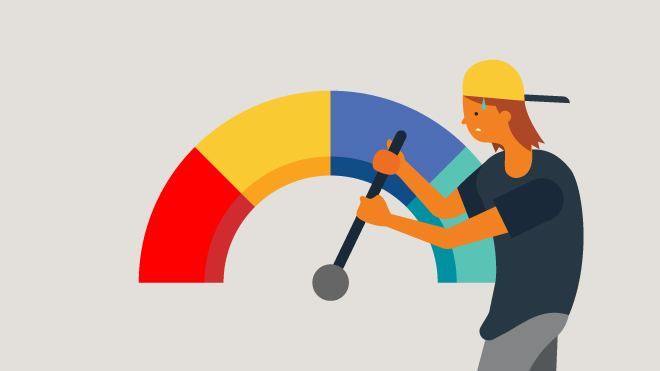
How To Pay off Credit Card Debt
Credit card debt can interfere with your long-term savings and spending goals. Our lead financial educator offers tips to help you pay off your credit cards so you can plan future purchases and prepare for the unexpected.
Living a debt-free life is a common goal — but paying off credit cards can feel like a never-ending battle. Pay too little, and the debt goes on forever. Pay too much, and you might not have enough to cover a surprise expense.
If you're carrying a balance on your credit cards from month to month, you're not alone.
Nearly half of American credit card holders carry a balance, too, according to a Bankrate survey. Emergency expenses were the primary cause of debt cited by Bankrate.
High costs for goods and services and high interest rates were also driving credit card balances up. In the third quarter of 2023, the average credit card debt in the U.S. was $6,088, the highest average balance per consumer in the last 10 years, according to TransUnion.
So how do you pay off your credit cards, especially with rising costs unexpected expenses? Stacey Black, BECU Lead Financial Educator, has some tips to help you break the debt cycle and be intentional about future spending.
5 Steps To Assess Your Spending
If you want to know how to pay off credit card debt, the first step is to figure out how much you spent and what you spent it on.
1. Review Past Spending Patterns
Sometimes deals are hard to resist, and impulse buys add up. Thinking about where and when you spent money can reveal whether you have been spending more than you want to. Maybe your favorite coffee shop appears on your statement more than you realized, or you're paying for a streaming service you no longer need.
Look back at your spending for recurring special occasions, like birthdays and holidays. Because those occasions come up every year, you can decide if you're spending the right amount and include them in your budget.
By evaluating how you spend, you could pay off your debt, make more intentional spending choices and might even have more money to save.
2. Make a List of Expenses
Start by listing everything you buy and the price. This includes monthly essentials, like utility bills, and fun expenses, like gifts and entertainment. Start by reviewing past purchases on your credit card statement or look them up on your credit card company's website. If you bought several items online from the same retailer, you can often check your order history on retailers' websites.
3. Track Your Current Spending
Black also recommends tracking your current spending for a month or two in a spending diary. She suggests free check register apps, spreadsheets and even a notebook and pen to write down every expense, regardless of the payment method. If you use an online money management tool, you can tag your purchases.
"My advice always is to do what works for you," Black said. "The best tool is the one you'll use consistently."
4. Understand Needs vs. Wants
Determine your spending needs vs. wants. Your needs are essential expenses like housing (rent or mortgage payment), utilities, childcare, car payment and food.
Cut back where you can — but try not to cut out all your wants. When people are too strict, they are more likely to give up and go back to overspending, so the occasional treat is fine. Even better is prioritizing a little fun and budgeting for it to avoid splurges.
5. Limit Your Credit Card Use
Only use your credit cards if you're sure you can pay off what you spend each month while continuing to pay down your balances. Otherwise, you'll continue adding to the debt you're trying to reduce.
If you have credit card information saved on shopping websites or in apps, it might be too tempting to use them. Consider removing those cards from online retailers' sites.
Commit to a Payment Amount
Once you know what your expenses are, compare that amount to your income. The amount you have left after expenses is the amount you can put toward paying down your debt. If your expenses are greater than your income, you have more work to do to reduce your spending.
Commit to paying the same amount every month, even as your credit card debt and required minimum payments decrease.
"As your balances go down, your minimum payments go down, and the effect of your payments goes up, so you'll start paying off your debt faster," Black said. "The momentum can be really motivating."
Choose a Payment Strategy
There isn't a one-size-fits-all approach to paying off credit cards. Just like tracking your spending, Black said to choose the strategy that's right for you.
"Decide which plan is the one you can stick with and hold yourself accountable," she said.
Remember you'll keep paying the same total amount every month toward your debt, even when your required payments decrease. Use a credit card debt repayment calculator to see how long it will take to pay it off.
Here are three popular — and effective — repayment methods:
1. Debt Snowball
To reduce your credit card debt using the debt snowball method, focus on paying off your lowest balance credit card first while paying at least the required minimum on your other cards. Once the lowest balance card is paid off, shift that payment to the next lowest balance card. Continue to do this until all your credit cards are paid off.
The total monthly payment for all your cards should remain the same until you are debt free.
This method requires that you have more than the combined total minimum payment of all your cards to put toward your debt.
2. Debt Avalanche
The debt avalanche method is like the snowball method, except you focus on paying off your highest interest rate card first while paying the minimum on the remaining cards.
Once you pay off the highest interest rate card, shift the payments to the next highest interest rate card while continuing to pay the minimums on the remaining cards.
Like the debt snowball, the total monthly payment for all your cards should remain the same until you are debt free, and this method requires that you have more than the combined total minimum payment of all your cards to put toward your debt.
3. Debt Cascade
Use the debt cascade method if all you can afford right now is the minimum payments on your credit cards. Eventually, the credit card company will lower the required minimum — but don't reduce your payment. Keep paying the same amount, and your debt will shrink faster and faster.
Once you pay off one credit card, redirect the funds you were using to another card, using one of the methods above.
Consider Balance Transfer Credit Cards
Taking advantage of a low-interest or no-interest balance transfer credit card offer can be a great way to reduce your debt, but be sure you do the math before you try this solution, because it might end up costing you the same or more in the long run.
Black advised asking yourself these questions before you make the switch:
- Will I qualify for the low-interest or no-interest balance transfer credit card offer? If getting a lower interest rate isn't a sure thing, then you might end up damaging your credit by applying for a new credit card. Plus, you might qualify for more credit, with a high interest rate, that you're tempted to use.
- Can I pay back enough of the debt in time to make the low interest offer and transfer fee worthwhile? If the no-interest balance transfer credit card lasts 12 months then jumps sky high, you'll want to be sure that a year is enough time to pay down your debt. Also keep in mind that most credit cards charge a balance transfer fee. Some range from 3% to 5% of the amount you plan to transfer.
Balance Transfer Calculator
Credit Karma has a free and easy-to-use balance transfer calculator.
After you figure out how much you can pay off during the promotion period, you can switch over to a debt repayment calculator to figure out how long it will take you to pay off the remaining balance and how much interest you'll pay at the new rate. Then decide if it's worth it to apply for more credit.
With any credit card offer, read the details before you apply.
Research Debt Consolidation Loans
Debt consolidation loans can be another great tool for debt reduction — but use caution.
"Before you take out a loan, it's important to create a budget and really know where you stand," Black said. "Think about your financial situation and how you got into debt in the first place."
If you have too many financial obligations or you don't have control over your spending behavior, you're likely to start charging your purchases again and end up with even more debt than you started with.
Save for the Future
Having a strategy to get out of debt and sticking to it is great, but you also need a savings plan to prevent yourself from going into debt again when you make your next big purchase, or in case of an emergency. Start saving now while you're paying off credit card debt.
1. Set a Savings Goal
Identify any high-cost items you want to pay for in the future, such as a vacation, a car or gifts for family and friends. Total up how much you plan to spend and divide it up to determine your savings goal. You can divide by 12 to set aside money monthly or by the number of paychecks you receive and save when you get paid.
2. Separate Your Money
If you put all your money in one place, it can be difficult to keep track of it and it can be easier to spend. Consider opening separate accounts. Nickname your accounts based on what you're saving for — "New Car" or "Holiday Savings," for example, and use those accounts only for their named purpose.
You can also use digital tools to separate your money into different categories without opening new accounts. BECU Envelopes is an example.
3. Set Up Automatic Savings
Most credit unions and banks have automatic savings plans that allow you to transfer a fixed amount of money automatically into your savings account. Your new savings balance will grow instead of your credit balance.
Create a Budget and Stick to It
Now you know how to pay off credit card debt and save money for future spending — both your needs and your wants.
"It takes time and commitment to get out of debt and break that cycle," Black said. "But it's such a relief for people when they are finally debt free."
Resources
The above article is intended to provide generalized financial information designed to educate a broad segment of the public; it does not give personalized financial, tax, investment, legal, or other business and professional advice. Before taking any action, you should always seek the assistance of a professional who knows your particular situation when making financial, legal, tax, investment, or any other business and professional decisions that affect you and/or your business.


